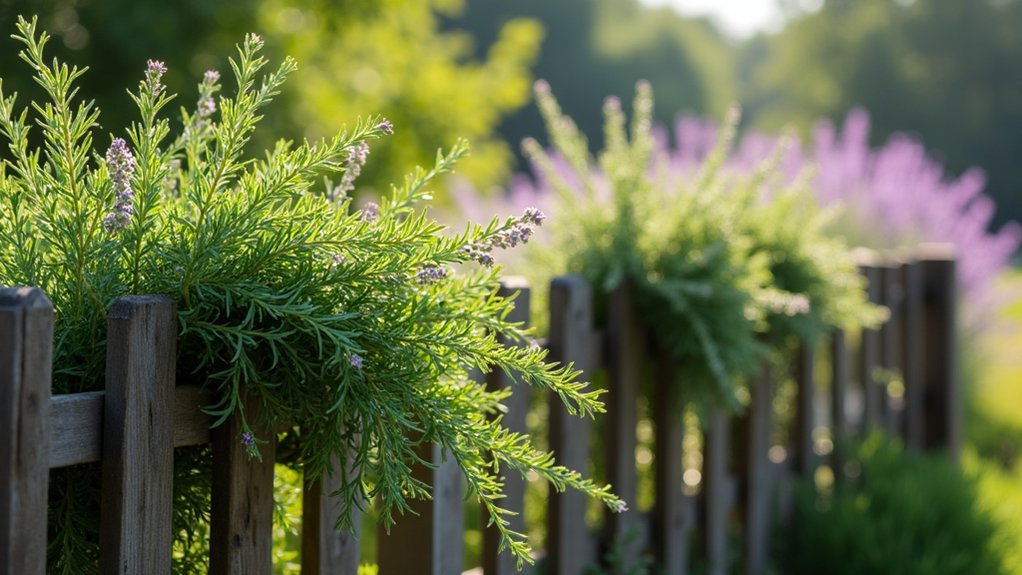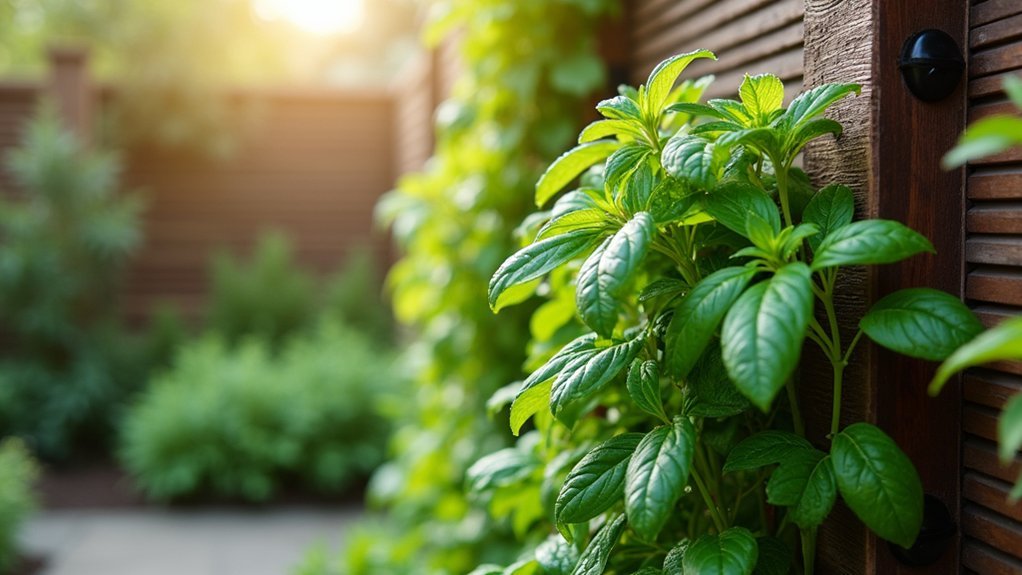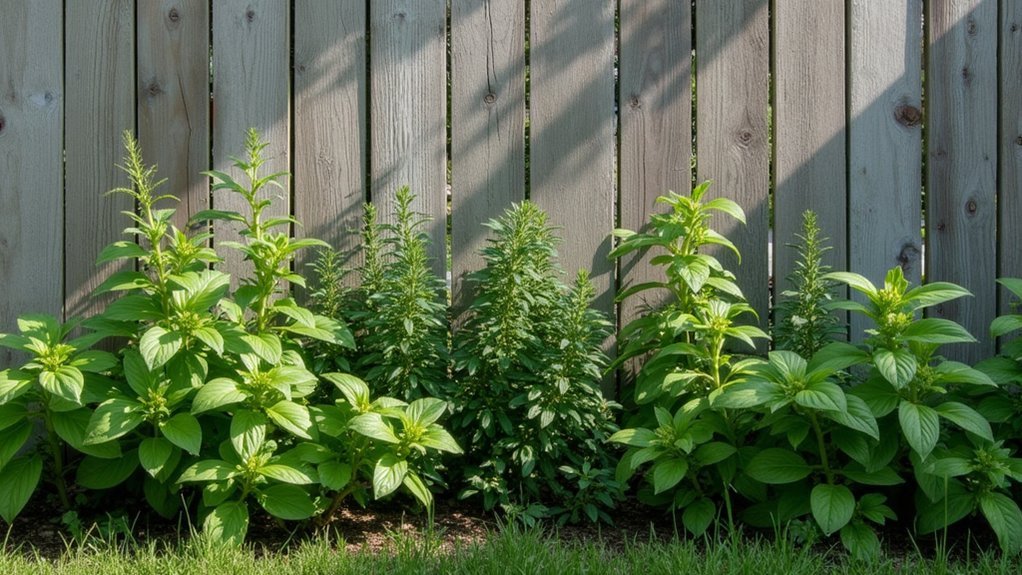Create a dual-purpose fence by integrating aromatic herbs like lavender, rosemary, and thyme along your garden boundaries. You’ll gain natural pest deterrents while enhancing visual appeal with varied textures and heights. Plant taller herbs like sage and fennel for privacy, and pair companions strategically (basil with tomatoes, mint near cabbage) to maximize space and create a resilient ecosystem. Regular maintenance through pruning prevents overgrowth. Discover how your garden borders can protect, produce, and please the senses simultaneously.
Aromatic Barriers: Selecting the Right Herbs for Fence Integration

While traditional fences merely define boundaries, incorporating fragrant herbs transforms them into multifunctional assets for your garden.
Lavender, rosemary, and thyme create effective aromatic barriers that not only smell delightful but naturally deter unwanted pests through their potent scents.
For visual appeal, integrate herbs with varied textures like chives and basil along your fence line.
Taller varieties such as sage and fennel serve as natural privacy screens while attracting beneficial insects to your garden ecosystem.
Choose plants that thrive in your specific climate and soil conditions to guarantee robust growth year-round.
Mint and oregano provide lush ground coverage while offering fresh ingredients for your kitchen.
You’ll enjoy the practical benefits of these dual-purpose plantings while enhancing your garden’s aesthetic charm.
Structural Considerations for Living Herb Boundaries
When designing living herb boundaries, you’ll need to assess the weight-bearing capacity of your supporting structures to prevent collapse as plants mature and gain mass.
Managing root systems through proper spacing and containment methods prevents invasive spread while ensuring each herb receives adequate nutrients without compromising structural integrity.
Your boundary design should incorporate weather resilience elements like windbreaks or drainage channels to protect delicate herbs from extreme conditions while maintaining the fence’s functional strength year-round.
Weight-Bearing Capacity Factors
Because living herb boundaries serve as both decorative and functional elements, understanding their weight-bearing capacity becomes essential for long-term success.
You’ll need to select well-draining soil that provides ideal support for plant roots, enhancing the structural integrity of your herb boundary.
Consider the varied root structures of herbs like rosemary and thyme when planning your fence. These differences greatly affect weight distribution throughout the boundary.
The height and density of your selected plants will determine what additional supports you’ll need—taller varieties require more robust reinforcement to prevent collapse.
Don’t overlook the importance of regular maintenance through pruning and soil aeration to maintain weight-bearing capacity over time.
Always factor in the mature size and weight of your chosen herbs to prevent overloading your fence structure.
Root System Management
Although often overlooked, root system management forms the critical foundation of any successful herb boundary fence. You’ll need to guarantee herb roots work with—not against—your fence structure. Most herbs require 12-18 inches of depth for healthy growth while maintaining boundary stability.
| Herb Type | Root Behavior | Management Strategy |
|---|---|---|
| Aggressive (Mint) | Spreads rapidly | Install landscape fabric barriers |
| Moderate (Rosemary) | Medium depth | Standard spacing from fence |
| Shallow (Thyme) | Minimal spread | Direct planting acceptable |
Consider implementing raised beds to control root expansion while creating an attractive boundary element. This approach prevents aggressive root systems from undermining fence foundations. Strategic placement of landscape fabric between herb plantings and your fence provides additional protection, guaranteeing your dual-purpose boundary maintains both structural integrity and herbal productivity with minimal maintenance.
Weather Resilience Design
Beyond proper root management, your herb fence must stand strong against nature’s challenges.
Creating weather-resilient herb boundaries requires thoughtful planning and structural support. You’ll need to select hardy herbs like rosemary and thyme that withstand drought while incorporating supports that transform your living boundary into a solid fence system.
- Install trellises or wire frames to prevent collapse during high winds and heavy rain
- Mix soil with excellent drainage properties to avoid root rot in wet conditions
- Implement companion planting strategies to improve pest resistance and overall vigor
- Maintain regular pruning schedules to strengthen plants and remove vulnerable growth
Seasonal Planning for Year-Round Herb Fence Appeal
While most garden elements hibernate during winter months, a thoughtfully designed herb fence can remain functional and attractive throughout all seasons.
Your seasonal planning should incorporate both perennial herbs like rosemary and thyme for year-round structure, alongside rotating annuals such as basil and cilantro during warmer months.
Create a planting schedule that guarantees continuous harvests while allowing soil rest periods. You’ll enjoy fresh herbs for cooking regardless of the season.
Enhance your herb fence’s visual appeal by incorporating seasonal touches—pumpkin vines climbing through in autumn or festive herbs for winter gatherings.
Don’t neglect maintenance as seasons change. Regular pruning and adjusted watering schedules keep your plants healthy and productive.
With thoughtful design, your dual-purpose herb fence will serve as both a beautiful boundary and practical garden feature every month of the year.
Irrigation Systems for Vertical Herb Boundaries

Because vertical herb boundaries stack plants above one another, they require specialized irrigation solutions to guarantee every plant receives adequate moisture.
Setting up a drip irrigation system delivers water directly to plant roots, minimizing waste while ensuring consistent hydration throughout your vertical herb display.
- Install a timed irrigation controller to schedule precise watering based on each herb’s specific needs.
- Incorporate soaker hoses to efficiently distribute water while reducing evaporation and runoff.
- Consider rainwater harvesting as a sustainable water source for your vertical herb boundaries.
- Use moisture sensors to monitor soil conditions and optimize your watering schedule.
You’ll find these irrigation systems not only save water but also reduce maintenance time, allowing your herb fence to thrive with minimal intervention.
This creates a lush, productive boundary that serves both aesthetic and practical purposes.
Companion Planting Strategies Within Fence Designs
Companion planting transforms your herb boundary from a simple divider into a thriving ecosystem where plants support one another. By strategically positioning herbs alongside flowering plants, you’ll maximize space while creating a pest-resistant vertical garden that’s both beautiful and productive.
| Herb | Companion | Benefit | Placement |
|---|---|---|---|
| Basil | Tomatoes | Improves flavor | Lower fence |
| Rosemary | Lavender | Deters pests | Border edges |
| Mint | Cabbage | Repels insects | Contained areas |
| Dill | Cucumbers | Attracts pollinators | Fence trellises |
You’ll find that integrating chives near roses or oregano alongside peppers creates mutually beneficial relationships. Install trellises for climbing herbs like beans to utilize vertical space efficiently. This companion planting approach guarantees your fence design serves multiple purposes—defining boundaries while nourishing your garden ecosystem.
Harvesting Techniques That Maintain Boundary Integrity

Harvesting herbs from your living fence requires thoughtful technique to preserve its dual function as both boundary and pantry. Snip stems above leaf nodes during morning hours after dew has dried to encourage bushier growth while maintaining your fence’s structure. This careful harvesting approach guarantees your edible garden remains both productive and well-defined.
- Create staggered planting layers for easy access without compromising the boundary
- Mark designated harvesting zones with small stakes to prevent overharvesting
- Collect herbs in the morning to preserve essential oils and minimize boundary disruption
- Implement regular trimming to prevent herbs from overtaking the fence line
These harvesting techniques balance your need for fresh herbs with maintaining boundary integrity, creating a living fence that’s both functional and flavorful year-round.
Pest-Deterrent Herb Combinations for Protective Borders
While creating a beautiful boundary, strategic herb combinations form a powerful defense system against garden pests.
Plant lavender, rosemary, and mint around your garden’s perimeter to naturally repel mosquitoes, aphids, and rabbits. You’ll find that basil and marigold work wonderfully together, not only deterring unwanted visitors but also attracting beneficial pollinators to your space.
Create a natural fortress of fragrant herbs that both defends your garden and welcomes helpful pollinators.
For maximum effectiveness, establish dense plantings of lemon balm or catnip as physical barriers that pests hesitate to cross.
Sage and thyme emit scents that confuse pests, making them perfect additions to protective borders surrounding your edible plants.
This companion planting approach with pest-deterrent herbs reduces your need for chemical treatments, creating a healthier, more sustainable garden ecosystem that serves both defensive and decorative purposes.
Frequently Asked Questions
What Is the Best Shrub to Line a Fence?
For fencing, you’ll love evergreen shrubs like arborvitae or boxwood for year-round privacy. If you want quick results, choose privet or photinia. For beauty and pollinators, try lilacs or hydrangeas instead.
What Is the Cheapest Type of Boundary Fence?
The cheapest boundary fence is simple wire fencing at $1-5 per linear foot. You’ll also find temporary plastic barriers under $1 per foot, while chain link offers an affordable permanent solution for your property perimeter.
How Close Can You Plant Next to a Fence?
You should leave 12-18 inches between plants and your fence for proper airflow. Sun-loving herbs need 2-3 feet from tall fences that cast shade. Less invasive herbs like basil can be planted 6-12 inches away.
What Can I Plant Around a Split Rail Fence?
Around your split rail fence, you can plant low-growing herbs like thyme or creeping rosemary, taller varieties such as lavender or sage, and edible options including chives or oregano for both beauty and function.
In Summary
You’ve now got everything needed to create your living boundary that serves both your garden’s aesthetic and culinary needs. Remember, your dual-purpose herb fence isn’t just a border—it’s a productive ecosystem that’ll evolve with the seasons. Start small, expand gradually, and you’ll soon enjoy fresh harvests while defining your space beautifully and functionally. The perfect blend of utility and design awaits in your garden.





Leave a Reply